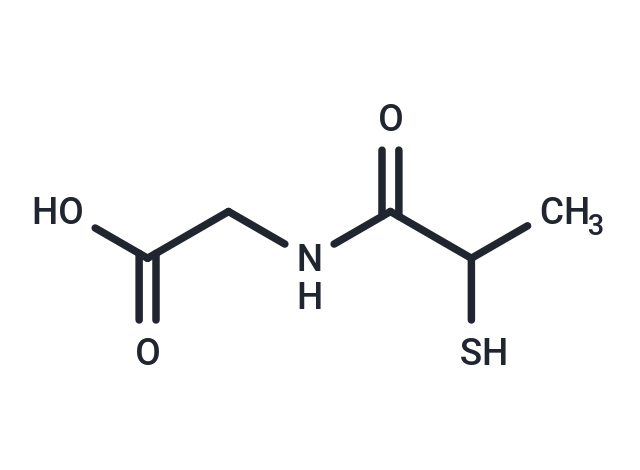Shopping Cart
- Remove All
 Your shopping cart is currently empty
Your shopping cart is currently empty

Tiopronin (Acadione), a sulfhydryl acylated derivative of glycine, leads to a reduction in urinary cystine concentration and subsequently reduces cystine stone formation.

| Pack Size | Price | Availability | Quantity |
|---|---|---|---|
| 1 g | $39 | In Stock | |
| 1 mL x 10 mM (in DMSO) | $29 | In Stock |
| Description | Tiopronin (Acadione), a sulfhydryl acylated derivative of glycine, leads to a reduction in urinary cystine concentration and subsequently reduces cystine stone formation. |
| In vitro | Tiopronin is an antioxidant with a free thiol (sulfidryl) group that has been shown to protect against cisplatin nephrotoxicity both in vitro and in vivo. Tiopronin improves the defence of the cochlea and scavenge the reactive oxygen species, whereas vitamin E (a-tocopherol) and vitamin C act by inhibiting lipid peroxidation and preventing free radical formation. [1] Tiopronin (2 mM) completely prevents the Cisplatin-induced increase in enzyme leakage and substantially blocks the decrease of MTT reduction caused by Cisplatin. Tiopronin also significantly protects the renal slices from cisplatin-induced toxic effects. Tiopronin protects against cisplatin-induced nephrotoxicity by acting as an alternative target for Cisplatin both intra- and extracellularly and thus protects against cisplatin-induced depletion of glutathione in the kidney cell. [2] Tiopronin protects rat kidney slices in vitro from the nephrotoxic effects of Cisplatin and does not reduce the antitumour activity of Cisplatin. Tiopronin provides marked protection againstcisplatin-induced increases in urea and creatinine. [3] Tiopronin protects against Cisplatin-induced changes in the adenine nucleotides in rat renal cortical slices. [4] |
| In vivo | Tiopronin significantly lowers both the serum alanine aminotransferase (ALT) and aspartate aminotransferase (AST) levels, while only the serum ALT level is lowered by ursodeoxycholic acid (UDCA) in rats. Tiopronin significantly decreases the serum and liver levels of triglyceride (TG), total cholesterol (TC) and free fatty acids (FFA) as well as the serum LDL-C level, and increases the serum HDL-C level. [5] |
| Alias | Thiopronine, Captimer, Acadione |
| Molecular Weight | 163.19 |
| Formula | C5H9NO3S |
| Cas No. | 1953-02-2 |
| Smiles | C(NCC(O)=O)(C(C)S)=O |
| Relative Density. | 1.249 g/cm3 (Estimated) |
| Storage | Powder: -20°C for 3 years | In solvent: -80°C for 1 year | Shipping with blue ice. | |||||||||||||||||||||||||||||||||||
| Solubility Information | Ethanol: 30 mg/mL (183.8 mM) H2O: 29 mg/mL (177.7 mM) DMSO: 70 mg/mL (428.95 mM), Sonication is recommended. | |||||||||||||||||||||||||||||||||||
Solution Preparation Table | ||||||||||||||||||||||||||||||||||||
H2O/Ethanol/DMSO
| ||||||||||||||||||||||||||||||||||||

Copyright © 2015-2024 TargetMol Chemicals Inc. All Rights Reserved.